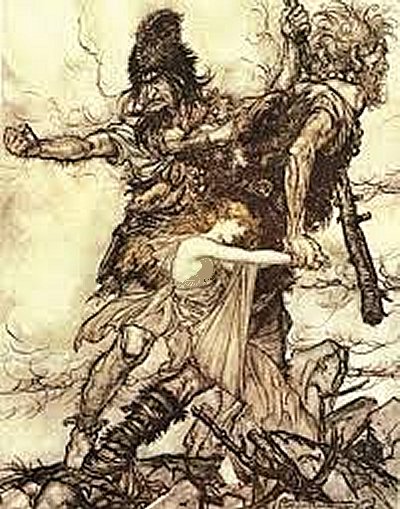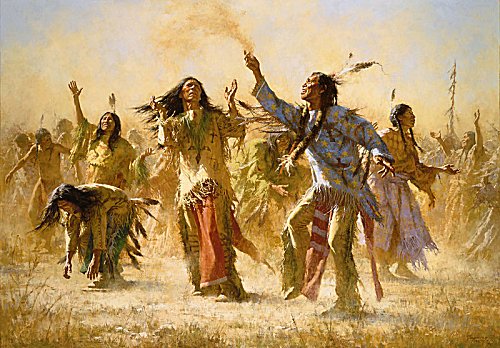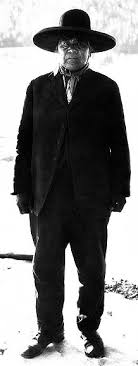 |
SPIRIT
LODGE
LIBRARY
Myth
& Lore
Page
14
|
(Main
Links of the site are right at the bottom of the page)
Some of the 86 pages in this Myth & Lore section are below.
The rest will be found HERE
Ghost Dance
By CinnamonMoon

Hope
Springs Eternal-Ghost Dance 1987 © Howard Terpning
From: The Encyclopedia of Native
American Religions by Arlene Hirschfelder and Paulette Molin
GHOST DANCE of 1870
A religious movement that originated among the Northern Paiute
of the Walker River Reservation in Navada and was founded by
the prophet Wodziwob. In the late 1860's he made a number of
prophecies, including the resurrection of the dead and the restoration
of the conditions that existed before Europeans arrived in the
region. The movement arose among the Paiute people at a time
of great suffering and deprivation. Besides losing their traditional
landbase and means of subsistence, other calamities had occurred,
including a drought, starvation and epidemics.
Elements identified with the Ghost
Dance included curing and increase rites, practice of traditional
Paiute Round Dance as a vehicle for the movement and an attempt
to introduce the Cry Dance, a mourning ceremony to the Walker
River people. The religious movement spread to California tribes
and to the Great Basin, where local variations occurred. On
the Klamath Reservation in Oregon, it developed into the Earth
Lodge Religion and later the Dream Dance.
The Big Head Religion and the Bole-Maru
Religion were also offshoots of the Ghost Dance. It's abrupt
end after two or three years on the Walker River Reservation
among its originators has been attributed to disillusionment
over unfulfilled prophecies. Some of the other groups who adopted
it continued to perform it. Adherents to the Ghost Dance included
Joijoi, Norelputus and Frank Spencer.
GHOST DANCE of 1890
A messianic religious movement that began among the Paiute people
in Nevada in the late 1880's and quickly spread to other tribal
groups. it was originated by Wovoka, a Paiute prophet, who was
influenced by earlier visionaries among his people. At the end
of 1889, an eclipse of the sun occurred. During that period
Wovoka had a visionary religious experience. He was taken to
the spirit world where he was given sacred teachings.
Wovoka returned with a message of
hope and peace for Indian people. He told them that the earth
would be renewed, the Indian dead would return to life and misery
and death would end if they followed the revelations he had
received. Wovoka told the people to be good to one and other,
to be at peace with the whites, to be industrious and not to
engage in lying, stealing and other wrongdoing.
He also told them to perform a dance
for five days at a time in order to bring about the changes.
As Wovoka's prophecies spread, distant tribes sent emmissaries
to find out about the rumored messiah and his teachings, including,
in 1889, a delegation of Plains tribal leaders such as Kicking
Bear, Porcupine, Short Bull and Sitting Bull (Arapaho).
The Ghost Dance eventually numbered
followers among other Great Basin groups, and its practice extended
from the Missouri River to the Rocky Mountains and beyond, representing
a religious means of enduring the conditions under which native
people suffered during that period.
Local variations in the movement developed as tribes incorporated
it into their own religious traditions, leaders added new interpretations
and practitioners learned new songs and teachings during performances
of the sacred dance. Some adherents believed that whites would
disappear from the country while others believed that they would
remain.
The dance itself was a circle dance,
but performances of the dance varied. some incorporated a center
pole or tree in the dance area, sweat lodge purification, preliminary
dances, dances of varied duration and other elements. "Ghost
shirts," believed to be bullet-proof, were adopted by the
Lakota, Arapaho and other groups and were worn during dance
performances. Many dancers also experienced trances during which
they visited departed friends and relatives and learned sacred
knowledge.
Translations of some of the tribal
names of the religion include "dance in a circle"
(Paiute), "dance with clasped hands" (Kiowa) and "with
joined hands" (Comanche). It was also referred to as a
spirit or ghost dance in many native languages because of its
association with the return of the Indian Dead.
Sacred Ghost Dance songs proliferated,
many of them referring to the restoration of the buffalo and
other game as well as to departed friends and relatives.
The Ghost Dance met with particular
repression and the government's opposition to the Ghost Dance
was a continuation of its earlier suppression of other traditional
religious practices. As the movement gained more and more followers,
fear and hysteria escalated among the whites. Military intervention
was used in the Dakotas--its tragic outcome was the massacre
of Lakota men, women and children at Wounded Knee on December
29, 1890.
Although the Ghost Dance is believed
to have ended then, there is evidence that some tribal groups
were able to continue it for a longer period of time. Among
the Kiowas, Afraid-of-Bears developed an interpretation of the
ghost Dance that he called the Feather Dance. Other Ghost Dance
leaders included Black Coyote and Fred Robinson.
 |
WOVOKA Wagud,
"Wood-cutter" (c. 1856-1932) Paiute.
The prophet who founded the Ghost Dance of 1890. Born
about 1856 near Walker Lake in present-day Esmeralda County,
Nevada, he was the son of TaviBo (also Numu-tibo'o), a
visionary and leader.
Known as Wovoka
or Wuvoka from his youth, he later took the name of his
paternal grandfather, Kowhitsaug ("big rumbling belly").
Wovoka was eventually
influenced by a neighboring white farmer, David Wilson,
and Wilson's family, who gave him the name Jack Wilson.
Wovoka later worked on the family's farm and, when he
was in his 20's, married Tumma, who became known as Mary
Wilson.
Wovoka's great
revelation occurred on January 1, 1889, during an eclipse
of the sun. He first heard a 'great noise' then lost consciousness.
When he revived, he announced that he had been taken to
the other world where he had seen the Creator and people
who had died. Wovoka was given
a number of powers there, including five songs for weather
control, invulnerability to weapons, political responsibility
and prophecies. The Creator instructed Wovoka to return
to his people and to instruct them to live in peace without
warfare, lying or stealing. they were to work and live
in peace with the whites. If they obeyed these instructions,
they would be reunited with family and friends in the
other world, where there would be no sickness, old age
or death.
|
Wovoka taught a sacred dance, known
to the Northern Paiute as nanigukwa, "dance in a circle,"
which was to be performed at intervals for five consecutive
days. Out of Wovoka's experience of death and rebirth, the religious
practices of his family and tribe, and his exposure to the Presbyterian
beliefs of the Wilsons, evolved the Ghost Dance religion, which
quickly spread to other tribal groups. Emissaries representing
over 30 tribes traveled great distances to visit him and to
learn more of his teachings, often returning home filled with
messages of hope for their people.
Some of the visitors from the Plains
included Kicking Bear, Porcupine, Short Bull, Sitting Bull (Arapaho)
and Wooden Lance. As the religious movement spread, it took
on features unique to individual tribal groups. The Ghost Dance
was opposed by government agents and missionaries, and efforts
to suppress the movement ended in tragedy among the Lakota.
Federal troops opened fire on Big
Foot's band at Wounded Knee in South Dakota on December 29,
1890, killing men, women and children. In the aftermath of the
events on the Northern Plains, Wovoka continued to receive correspondence
from Ghost Dance adherents. Assisted by Ed Dyer, a store owner
who served as his secretary, the Paiute prophet mailed sacred
red ocher, eagle or magpie feathers, Stetson hats and other
clothing he had worn to those who made requests and sent money.
He also traveled to distant reservations, served as a shaman
and healer, sought land on the Walker River Reservation in Nevada
and continued to believe in his political and spiritual powers.
Wovoka spent the last 15 years of
his life at the Yerington Indian Colony in Nevada. Before he
died he prophesied that an earthquake would occur if he reached
the other world again. Wovoka died at his home on September
29, 1932.
Other names for the prophet included
Wevokar, Wopokahte, Cowejo, Koit-tsow, Quoitze Ow, Jackson Wilson
and Jack Wilson. He was also referred to as Tamme Naa'a, "Our
Father," and the Messiah.
***Note, I did a search and found
these images for the Ghost Dance so felt they would be an additional
help for some of you looking to see the costumes, movements,
etc. that were employed in this practice. Here's a link for
that site:
https://www.google.com/search?q=ghost+dance+movement&oe=utf-8&rls=org.mozilla:en-US:official&client=firefox-a&um=1&ie=UTF-8&ei=FAeUS9aJCo_cNqbIlPgM&sa=X&oi=image_result_group&ct=title&resnum=4&ved=0CBwQsAQwAw&tbm=isch&gws_rd=ssl
|
|
|
|
|
|
|
|
|
|
|
|
Libraries
are on this row
|
|
|
INDEX
Page 3
(Main Section, Medicine Wheel, Native Languages &
Nations, Symbology)
|
|
INDEX
Page 5
(Sacred Feminine & Masculine, Stones & Minerals)
|
|
|
|
|
|
|
©
Copyright: Cinnamon Moon & River WildFire Moon (Founders.)
2000-date
All rights reserved.
Site
constructed by Dragonfly
Dezignz 1998-date
|
|